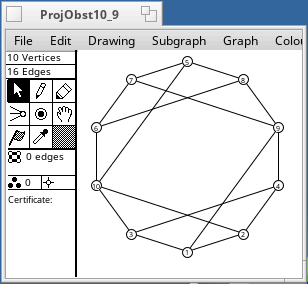Projective Plane Obstructions
Last update=30 May, 2018

A non-planar graph is one which cannot be embedded in the plane. Kuratowski's theorem says that a graph G is non-planar iff it contains a subgraph topologically equivalent to one of K3,3 or K5. In terms of graph minors this can be expressed by saying that G has no minor K3,3 or K5. This is because a graph minor of G is any graph that can be formed by deleting vertices or edges of G, or by contracting edges of G. So we can say that K3,3 and K5 are minor-order obstructions to planarity. Thus there are two graphs that are minor-order obstructions to planarity, because they are the unique two minimal non-planar minors.
A non-projective graph is one which cannot be embedded in the projective plane. There are 35 minor-order obstructions to projective planarity. They were found by Glover, Huneke and Wang in 1979. Any graph that has one of these as a minor is non-projective. The smallest has 7 vertices, and the largest has 12 vertices (2K6). Some of them are shown below.








These graphs were drawn from adjacency matrices supplied by Wendy Myrvold. It is still not known how many minor-order obstructions there are for the torus. Myrvold has found tens of thousands, and it is not known whether her list is complete.

Download:

